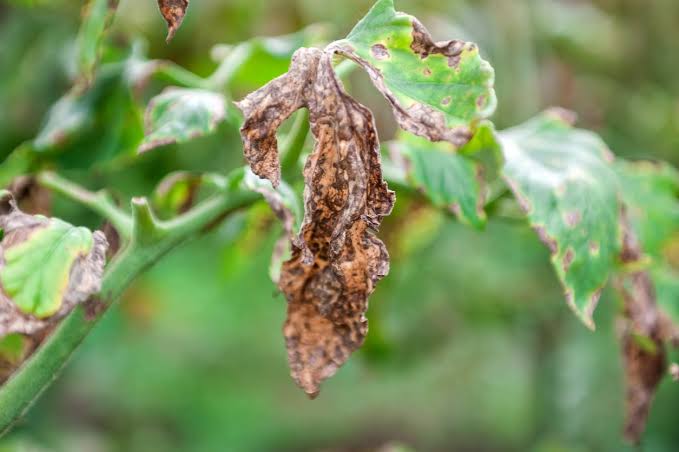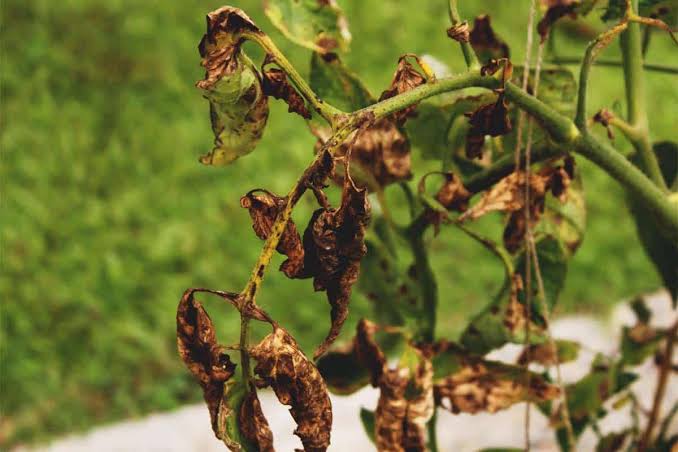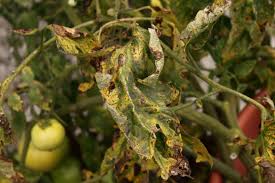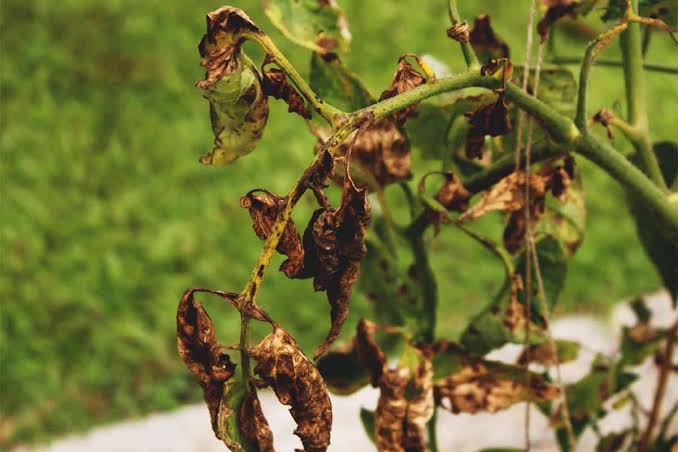Verticillium wilt is a plant disease caused by fungi belonging to the genus Verticillium, its scientific name is Verticillium spp. This ailment affects a wide range of plants, from vegetables and fruits to ornamental trees and shrubs. Understanding the basics of Verticillium wilt is crucial for farmers, gardeners, and horticulturists to mitigate its impact on crops.
The fungi responsible for Verticillium wilt live in the soil and can persist for several years. They enter plants through their root systems and then colonize the vascular tissues, disrupting the flow of water and nutrients. This disturbance leads to characteristic symptoms, such as wilting, yellowing of leaves, and premature defoliation.
One of the challenges with Verticillium wilt is its ability to infect a diverse array of plant species. This adaptability makes it a formidable adversary in agricultural and horticultural settings. Moreover, the symptoms often resemble those caused by other factors, making accurate diagnosis essential for effective management.
Management strategies for Verticillium wilt include cultural practices, such as crop rotation, which helps reduce the pathogen’s population in the soil. Planting resistant varieties is another approach, although resistance can vary among different plant species. Additionally, maintaining proper soil health and avoiding stress factors, such as excessive irrigation or poor drainage, can contribute to preventing infection.
It’s important to note that chemical treatments may offer limited efficacy against Verticillium wilt. Therefore, an integrated approach combining various control measures is often recommended. Early detection and intervention play a crucial role in minimizing the disease’s impact on crop yields and ornamental plants.
Research into Verticillium wilt continues to explore new avenues for control and prevention. Understanding the biology of the pathogen and its interactions with different plant species is fundamental for developing sustainable and effective management strategies.
Verticillium wilt poses a significant threat to a wide range of plants, impacting agricultural productivity and ornamental landscapes. Awareness of its symptoms, preventive measures, and ongoing research efforts are vital for safeguarding plant health and ensuring sustainable crop production.
Read Also: Leaf Spot Diseases: Description, Damages Caused, Control and Preventive Measures
Plants Affected by Verticillium Wilt (Verticillium spp.)

Verticillium wilt can affect a broad spectrum of plants, encompassing both food crops and ornamental species. Some notable examples include:
1. Tomatoes (Solanum lycopersicum): Tomato plants are highly susceptible to Verticillium wilt, with symptoms including wilting of leaves, yellowing, and stunted growth.
2. Potatoes (Solanum tuberosum): This staple food crop can also fall victim to Verticillium wilt, impacting the quality and yield of potato tubers.
3. Eggplants (Solanum melongena): Like other members of the Solanaceae family, eggplants are susceptible to Verticillium wilt, leading to wilting and discoloration of leaves.
4. Strawberries (Fragaria × ananassa): This popular fruit crop can be affected by Verticillium wilt, causing reduced fruit production and overall plant decline.
5. Trees and Shrubs: Ornamental plants like maples, elms, and roses are also susceptible to Verticillium wilt. Trees infected with the pathogen may show symptoms like dieback, wilting, and yellowing of leaves.
6. Cotton (Gossypium spp.): Verticillium wilt can impact cotton plants, affecting fiber quality and yield.
7. Lettuce (Lactuca sativa): In some cases, lettuce crops can be vulnerable to Verticillium wilt, leading to reduced quality and yield.
8. Cucumbers (Cucumis sativus): Cucumber plants may experience wilting and reduced productivity when infected with Verticillium wilt.
9. Peppers (Capsicum spp.): Peppers, belonging to the same family as tomatoes and eggplants, can succumb to Verticillium wilt, resulting in wilted and discolored leaves.
Understanding the range of plants susceptible to Verticillium wilt is crucial for implementing effective preventive measures, such as crop rotation and the selection of resistant varieties, to minimize the impact of this fungal disease.
Damages Caused by Verticillium Wilt

Verticillium wilt inflicts various damages on plants, affecting both their overall health and productivity. The consequences of this fungal disease include:
1. Wilting: One of the primary symptoms of Verticillium wilt is wilting, where the leaves of affected plants lose their turgidity and become limp. This wilting occurs due to the blockage of the plant’s vascular system by the fungal pathogen, disrupting the flow of water and nutrients.
2. Yellowing of Leaves: Infected plants often exhibit yellowing or chlorosis of leaves. This discoloration results from the disruption of normal physiological processes caused by the invasion of the vascular tissues by Verticillium fungi.
3. Stunted Growth: Verticillium wilt can lead to stunted growth and reduced plant vigor. The impairment of nutrient and water transport within the plant hampers its ability to reach its full growth potential.
4. Premature Defoliation: The disease may cause premature shedding of leaves, further reducing the plant’s capacity for photosynthesis and negatively impacting overall plant health.
5. Reduced Yield: Crop plants affected by Verticillium wilt often experience a decline in yield. This can be particularly detrimental in agricultural settings where high productivity is crucial for economic viability.
6. Lower Quality of Fruits or Tubers: For fruit and vegetable crops, the quality of the harvested produce may be compromised. This can affect market value and consumer satisfaction.
7. Dieback of Branches: In trees and shrubs, Verticillium wilt can lead to the dieback of branches, negatively impacting the overall structure and aesthetics of the plant.
8. Long-Term Soil Contamination: The Verticillium fungi can persist in the soil for several years, making the affected area a potential source of infection for future crops. This long-term soil contamination poses challenges for sustainable agriculture.
9. Impact on Ornamental Landscapes: In ornamental plants, Verticillium wilt can mar the beauty of landscapes as affected trees and shrubs may show visible symptoms, diminishing their ornamental value.
Understanding the damages caused by Verticillium wilt is essential for implementing effective management strategies. Farmers, gardeners, and horticulturists need to be vigilant in detecting and addressing this disease to safeguard plant health and ensure the sustainability of crop production and landscaping efforts.
Read Also: Fusarium Wilt: Description, Damages Caused, Control and Preventive Measures
Control and Preventive Measures

Controlling and preventing Verticillium wilt involves a combination of cultural, biological, and chemical measures. Here are key strategies to manage this fungal disease:
1. Crop Rotation: Practice a systematic rotation of crops, avoiding planting susceptible species in the same location for consecutive seasons. This helps reduce the buildup of Verticillium wilt in the soil.
2. Resistant Varieties: Choose plant varieties that are resistant to Verticillium wilt whenever possible. Breeding programs have developed resistant cultivars for certain crops, providing a valuable tool in disease management.
3. Soil Solarization: This technique involves covering the soil with transparent plastic to capture solar energy and heat the soil. Solarization can help reduce the population of Verticillium fungi in the soil.
4. Proper Irrigation: Maintain proper soil moisture levels to minimize plant stress, as overly dry or waterlogged conditions can make plants more susceptible to Verticillium wilt. Drip irrigation is often recommended to avoid wetting foliage.
5. Soil Health Management: Implement practices that promote overall soil health, including organic matter incorporation and balanced nutrient management. Healthy soils contribute to robust plants that are better equipped to resist diseases.
6. Sanitation: Remove and destroy infected plant material to prevent the spread of the pathogen. This includes pruning and disposing of affected branches or entire plants.
7. Biological Controls: Some beneficial microorganisms in the soil can suppress Verticillium wilt. Using biopesticides or soil amendments containing these beneficial organisms may contribute to disease control.
8. Fallow Periods: Allow fallow periods in affected fields, where the land is left unplanted for a season. This helps reduce the population of Verticillium fungi in the soil.
9. Chemical Treatments: While chemical control is generally considered less effective for Verticillium wilt, fungicides containing active ingredients like thiophanate-methyl or propiconazole may provide some level of protection. However, their use should be carefully considered due to potential environmental impacts.
10. Early Detection: Regularly monitor plants for symptoms of Verticillium wilt. Early detection allows for prompt intervention and minimizes the spread of the disease.
11. Research and Development: Support ongoing research efforts to develop new resistant varieties and sustainable management practices. Staying informed about the latest findings in Verticillium wilt management is essential for effective disease control.
By integrating these measures into a comprehensive disease management plan, farmers and gardeners can mitigate the impact of Verticillium wilt, promote plant health, and sustain agricultural productivity.
Frequently Asked Questions (FAQs) About Verticillium Wilt (Verticillium spp.)
1. Q: What is Verticillium wilt, and how does it affect plants?
A: Verticillium wilt is a plant disease caused by fungi of the genus Verticillium. These fungi invade a plant’s vascular system, disrupting water and nutrient transport, leading to symptoms such as wilting, yellowing of leaves, and stunted growth.
2. Q: Which plants are most susceptible to Verticillium wilt?
A: Verticillium wilt can affect a wide range of plants, including tomatoes, potatoes, strawberries, trees (like maples and elms), cotton, and ornamental shrubs.
3. Q: How is Verticillium wilt transmitted?
A: The Verticillium fungi persist in the soil and enter plants through their root systems. The fungus can be introduced to new areas through contaminated soil, infected plant material, or even water.
4. Q: Can Verticillium wilt be cured once a plant is infected?
A: Unfortunately, there is no cure for Verticillium wilt once a plant is infected. Management strategies focus on preventing its spread and minimizing its impact.
5. Q: What are the common symptoms of Verticillium wilt in plants?
A: Symptoms include wilting, yellowing of leaves, stunted growth, premature defoliation, and in some cases, dieback of branches.
6. Q: How can Verticillium wilt be prevented in gardens or farms?
A: Prevention measures include crop rotation, planting resistant varieties, soil solarization, proper irrigation practices, soil health management, sanitation, and early detection.
7. Q: Are there chemical treatments for Verticillium wilt?
A: Chemical treatments, such as fungicides, may offer limited effectiveness. However, they are generally considered less reliable, and their use should be carefully considered due to potential environmental impacts.
8. Q: Can Verticillium wilt be transmitted to humans or animals?
A: No, Verticillium wilt is a plant-specific disease and does not pose a direct threat to humans or animals.
9. Q: How long does the Verticillium fungus persist in the soil?
A: Verticillium fungi can survive in the soil for several years, making long-term soil management crucial for disease control.
10. Q: Is there ongoing research on Verticillium wilt?
A: Yes, research is ongoing to develop new resistant varieties, sustainable management practices, and a deeper understanding of the biology of the Verticillium fungi. Staying informed about the latest findings is important for effective disease control.
Read Also: Financial Projections for Waste Management Business

